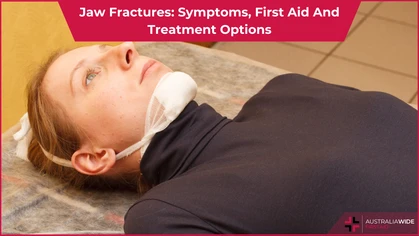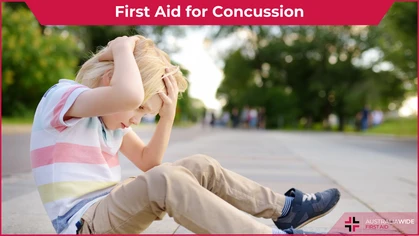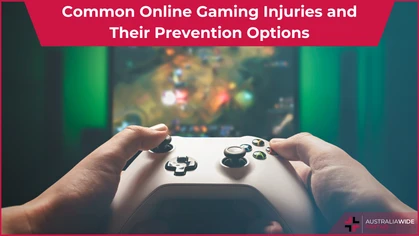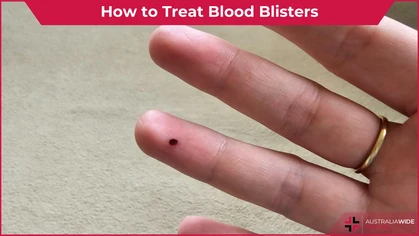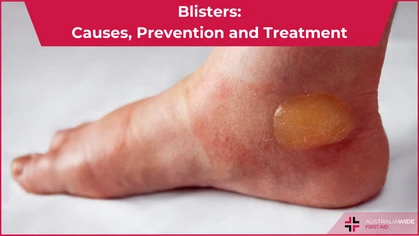How to Treat Australia's Most Common Minor Sports Injuries

Injury
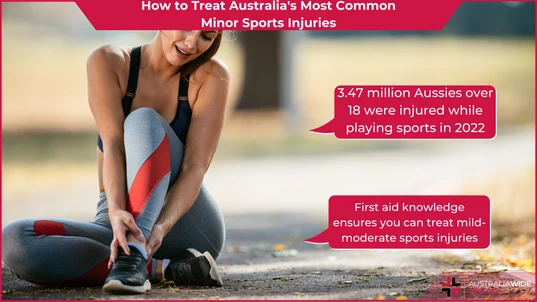 Playing sport is an essential part of life for many Australians, but it can also lead to injury.
A survey conducted by AusPlay in 2023 indicated that 18.27 million Australians over the age of 18 participated in at least one type of sport or physical activity in the previous 12 months.
19% of those who participated reported some form of injury (that is 3.47 million Australian adults). This number would be significantly higher if those under 18 were included in the survey.
About 52,300 of those injuries were serious enough to require a stay in hospital.
Fortunately, there are steps that participants can take to avoid sports injuries and to know what to do if they do occur.
This article provides an overview of how to recognize and treat Australia's most common mild to moderate sports injuries that do not require hospitalisation, as well as strategies for maintaining good health while playing sport. It also explains why taking a first aid course is essential for treating sports injuries.
Playing sport is an essential part of life for many Australians, but it can also lead to injury.
A survey conducted by AusPlay in 2023 indicated that 18.27 million Australians over the age of 18 participated in at least one type of sport or physical activity in the previous 12 months.
19% of those who participated reported some form of injury (that is 3.47 million Australian adults). This number would be significantly higher if those under 18 were included in the survey.
About 52,300 of those injuries were serious enough to require a stay in hospital.
Fortunately, there are steps that participants can take to avoid sports injuries and to know what to do if they do occur.
This article provides an overview of how to recognize and treat Australia's most common mild to moderate sports injuries that do not require hospitalisation, as well as strategies for maintaining good health while playing sport. It also explains why taking a first aid course is essential for treating sports injuries.
Recognizing Common Sports Injuries
Australia is a nation full of sports enthusiasts who play a variety of sports. Unfortunately, this often leads to sports injuries. It’s important for athletes to be aware of the most common injuries and how to treat them. The AusPlay study has identified outdoor team sports as having the highest injury rate, so if you participate in those, it is crucial for you to be aware. The most common sports injuries that often do not require hospitalisation in Australia include ankle sprains, hamstring strains, tennis elbow, groin strain, knee ligament injuries, and shoulder impingement. Ankle sprains are the most common and occur when the ligaments in the ankle are overstretched. Hamstring strains happen when the muscle fibres in the back of the leg are overstretched. Tennis elbow is an overuse injury that occurs when the tendons in the elbow become inflamed. Groin strain occurs when the muscles in the inner thigh are overstretched. Knee ligament injuries occur when the ligaments that support the knee are overstretched or torn. Shoulder impingement is an inflammation of the tendons and muscles in the shoulder. These injuries can be treated with rest, ice, compression, and elevation. If the injury is severe, medical attention should be sought out. Athletes should also take preventative measures such as stretching and strengthening exercises before and after physical activity.First Aid Responses for Sports Injuries
It is important for all sports enthusiasts and athletes to be aware of the most common sports injuries and how to treat them in the event of an accident. Knowing how to respond to an injury with first aid is a vital part of being prepared for any situation. Some of Australia’s most common sports injuries include sprains, strains, fractures, and contusions. For a sprain or strain, the key is rest, ice, compression, and elevation. To minimize swelling and pain, apply a cold compress, such as an ice pack, to the affected area. Place a compression bandage over the area and then keep it elevated. Fractures require medical attention, so if you suspect a fracture, call for medical help. Reduce the swelling by applying a cold compress and splint the area, if possible. A contusion, or bruise, may require an ice pack and compression bandage as well as elevation. It is also important to be aware of the signs of a concussion, which include confusion, dizziness, headache, memory loss, and nausea. If any of these symptoms are present, seek medical attention immediately. By being aware of these first aid responses for common sports injuries, athletes can be prepared to act quickly and appropriately in the event of an accident.Strategies for Maintaining Good Health in Sport
Staying healthy and injury-free is a key component of any successful sporting career. It is essential for athletes to be proactive in their approach to preventing and managing sports injuries. This article will discuss some strategies for maintaining good health in sport. Firstly, athletes should always warm up and cool down before and after physical activity. Dynamic stretching and light cardio exercises can help to prepare the body for activity and reduce the risk of injury. Additionally, athletes should ensure they are wearing the correct protection and equipment when playing sports, such as helmets and pads. Secondly, athletes should also focus on their nutrition and hydration. Eating a balanced diet and drinking plenty of water will help to keep the body fuelled and energised, while also aiding in injury prevention and recovery. Thirdly, athletes should also strive to maintain good physical and mental health. Regular exercise, adequate rest and relaxation, and engaging in activities to reduce stress can all help to keep athletes in peak condition. Finally, athletes should monitor their performance and track any changes in their health. Keeping a record of any injuries, and consulting with a doctor or physiotherapist if necessary, can help to identify any areas of concern and put plans in place to prevent future issues. By following these simple strategies, athletes can reduce the risk of injury and maintain optimal health and performance.Why Taking a First Aid Course is Essential for Treating Australia's Most Common Sports Injuries
Australia is a nation of sports lovers, and as such, injuries are all too common. Whether you’re an athlete, coach or parent, first aid training is essential for treating Australia’s most common sports injuries. Knowing how to properly respond to a sports injury is an incredibly valuable skill, and can even save lives. Taking a first aid course will provide you with the knowledge to treat minor injuries such as muscle sprains, cuts and abrasions, and more severe injuries like broken bones or concussions. Australia Wide First Aid offers a wide range of first aid courses, including HLTAID011 Provide First Aid, which covers the fundamentals of first aid for sports injuries. During this course, you will learn how to assess an injury and provide initial treatment, administer CPR, and identify when a patient needs to be taken to hospital. By taking a first aid course, you will be able to act quickly and confidently in the event of an injury. This will not only help to protect the health and safety of the injured person, but it may also prevent further injury and complications. Australia Wide First Aid’s HLTAID011 Provide First Aid course is an invaluable resource for anyone involved in sports. With the skills and knowledge gained from this first aid course, you will be able to provide the best possible care for those who suffer from Australia’s most common sports injuries.
Originally published at
https://www.australiawidefirstaid.com.au/resources/stay-safe-treating-sports-injuries-down-under
as part of the Australia Wide First Aid Articles Library


